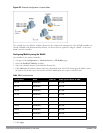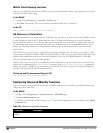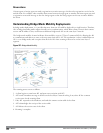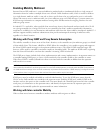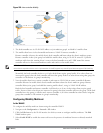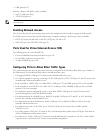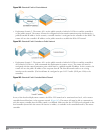
Enabling Mobility Multicast
Internet Protocol (IP) multicast is a network addressing method used to simultaneously deliver a single stream of
information from one sender to multiple clients on a network. Unlike broadcast traffic, which is meant for all hosts
in a single domain, multicast traffic is sent only to those specific hosts who are configured to receive such traffic.
Clients who want to receive multicast traffic can join a multicast group via IGMP messages. Upstream routers use
IGMP message information to compute multicast routing tables and determine the outgoing interfaces for each
multicast group stream.
In ArubaOS 3.3.x and earlier, when a mobile client moved away from its local network and associated with a VLAN
on a foreign controller (or a foreign VLAN on its own controller) the client’s multicast membership information
would not be available at its new destination, and multicast traffic from the client could be interrupted. ArubaOS 3.4
and later supports mobility multicast enhancements that provide uninterrupted streaming of multicast traffic,
regardless of a client's location.
Working with Proxy IGMP and Proxy Remote Subscription
The mobility controller is always aware of the client's location, so the controller can join multicast group(s) on behalf
of that mobile client. This feature, called Proxy IGMP, allows the controller to join a multicast group and suppresses
the client’s IGMP control messages to the upstream multicast router. (The client's IGMP control messages will,
however, still be used by controller to maintain a multicast forwarding table.) The multicast IGMP traffic originating
from the client will instead be sent from the controller’s incoming VLAN interface IP.
The IGMP proxy feature includes both a host implementation and a router implementation. An upstream router sees
a controller running IGMP proxy as a host; a client attached to the controller would see the controller as router.
When Proxy IGMP is enabled, all multicast clients associated with the controller are hidden from the upstream
multicast device or router.
NOTE: The newer IGMP proxy feature and the older IGMP snooping feature cannot be enabled at the same time, as both features
add membership information to multicast group table. For most multicast deployments, you should enable the IGMP Proxy feature on
all VLAN interfaces to manage all the multicast membership requirements on the controller. If IGMP snooping is configured on some
of the interfaces, there is a greater chance that multicast information transfers may be interrupted.
IGMP proxy must be enabled or disabled on each individual interface. To use the IGMP proxy ensure that the
VLANs on the Dell controllers are extended to the upstream router. Enabling IGMP proxy enables IGMP on the
interface and sets the querier to the controller itself. You must identify the controller port from which the controller
sends proxy join information to the upstream router, and identify the upstream router by upstream port so the
controller can dynamically update the upstream multicast router information.
Working with Inter controller Mobility
When a client moves from one controller to another, multicast traffic migrates as follows:
DellPowerConnectW-SeriesArubaOS6.2 | User Guide IPMobility | 504



